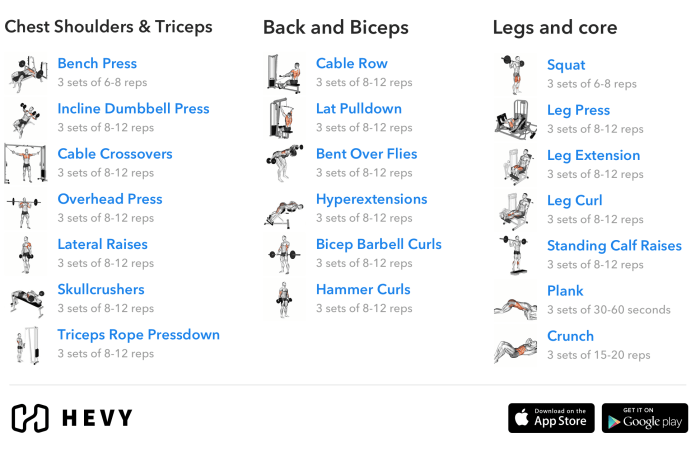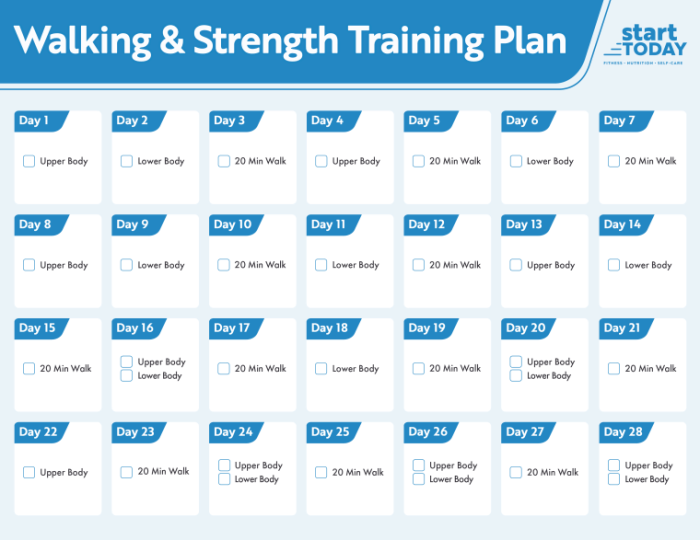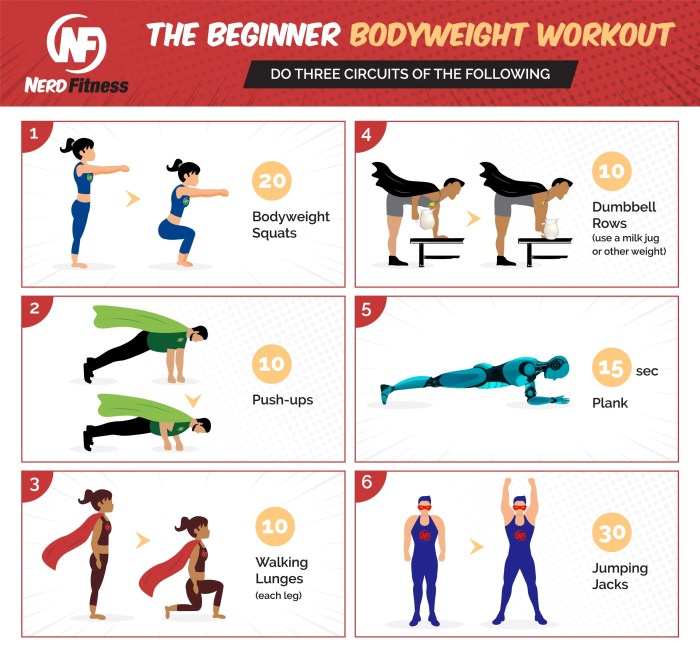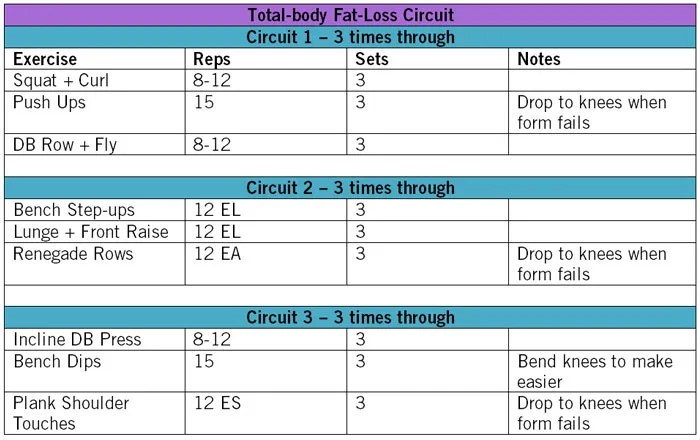Strength training routine weight loss is an effective approach to weight management that combines resistance exercises with a balanced diet and a consistent exercise regimen. It offers numerous benefits, including increased muscle mass, enhanced metabolism, and improved overall health.
This guide delves into the essential aspects of strength training for weight loss, providing detailed instructions, practical tips, and expert recommendations to help you achieve your fitness goals effectively and safely.
Introduction
Strength training, a form of exercise involving resistance, is a crucial component for weight loss. It helps you build muscle mass, which in turn increases your metabolism, the rate at which your body burns calories.
Resistance exercises, such as weightlifting, bodyweight exercises, and resistance band exercises, challenge your muscles to work against a force, leading to muscle growth and strength gains.
Role of Resistance Exercises
- Muscle Hypertrophy:Resistance exercises stimulate muscle growth by causing micro-tears in muscle fibers. During recovery, these fibers repair and rebuild, resulting in increased muscle size and strength.
- Metabolic Boost:Building muscle mass increases your resting metabolic rate (RMR), which means your body burns more calories even at rest. This is because muscle tissue is more metabolically active than fat tissue.
- Improved Body Composition:Strength training helps reduce body fat percentage while preserving or increasing muscle mass. This results in a leaner, more toned physique.
Types of Strength Training Exercises
Strength training exercises are classified into two main categories: compound and isolation exercises. Compound exercises work multiple muscle groups simultaneously, while isolation exercises focus on a single muscle group.
Compound Exercises
Compound exercises are highly effective for building overall strength and muscle mass. They engage multiple joints and muscle groups, making them efficient and time-saving.
- Barbell Squat:Targets the quadriceps, hamstrings, glutes, and core. Keep your feet shoulder-width apart, lower your body by bending your knees and hips, and return to the starting position.
- Bench Press:Targets the chest, shoulders, and triceps. Lie on a bench with your feet flat on the floor, lower the barbell to your chest, and press it back up to the starting position.
- Deadlift:Targets the hamstrings, glutes, back, and core. Stand with your feet hip-width apart, lower the barbell by bending your knees and hips, and lift it back up to the starting position.
- Overhead Press:Targets the shoulders, triceps, and upper back. Stand with your feet shoulder-width apart, hold the barbell overhead with your arms extended, and lower it behind your head.
- Pull-Up:Targets the back, biceps, and forearms. Hang from a bar with your palms facing you, pull yourself up until your chin is above the bar, and lower yourself back down.
Isolation Exercises
Isolation exercises target specific muscle groups, allowing for focused development. They are useful for isolating and strengthening weaker muscle groups or for shaping specific areas.
- Bicep Curl:Targets the biceps. Stand with your feet shoulder-width apart, hold a dumbbell in each hand with your palms facing up, and curl the dumbbells up to your shoulders.
- Triceps Extension:Targets the triceps. Stand with your feet shoulder-width apart, hold a dumbbell in each hand with your palms facing down, and extend your arms overhead.
- Leg Extension:Targets the quadriceps. Sit on a leg extension machine, place your feet on the platform, and extend your knees to lift the platform.
- Hamstring Curl:Targets the hamstrings. Lie on a hamstring curl machine, place your feet on the platform, and bend your knees to lift the platform.
- Calf Raise:Targets the calves. Stand with your feet shoulder-width apart, place your toes on a raised platform, and raise your heels to lift your body.
Designing a Strength Training Routine
Setting realistic goals is crucial for success. Start with a manageable weight and gradually increase it as you progress. Consistency is key, aim for 2-3 strength training sessions per week.
Determining Appropriate Weight, Sets, and Reps
Choose a weight that challenges you while maintaining good form. Start with 10-12 repetitions per set, aiming for 2-3 sets per exercise. As you get stronger, gradually increase the weight or reps.
Remember, weight loss is a gradual process. Focus on progressive overload, gradually increasing weight or reps over time, to continually challenge your muscles and promote growth.
Frequency and Intensity

To maximize weight loss through strength training, it’s crucial to establish an optimal frequency and intensity for your workouts. Research suggests that a combination of regular sessions and challenging intensity levels yields the best results.
For beginners, it’s recommended to start with 2-3 strength training sessions per week, gradually increasing to 3-4 sessions as you progress. Each session should last around 45-60 minutes, allowing for sufficient muscle stimulation without overexertion.
Progressive Overload
Progressive overload is a fundamental principle in strength training. It involves gradually increasing the weight, resistance, or sets and reps over time to continuously challenge your muscles and promote growth. By progressively overloading your muscles, you force them to adapt and become stronger, leading to increased calorie expenditure and fat loss.
Intensity Recommendations
The intensity of your strength training sessions should be challenging but not excessive. Aim for a weight or resistance that allows you to complete 8-12 repetitions of each exercise with good form while maintaining a slight burn in your muscles.
If you can easily complete more than 12 reps, it’s time to increase the weight or resistance.
Here’s a table summarizing the recommended frequency, intensity, and duration of strength training sessions for weight loss:
| Frequency | Intensity | Duration |
|---|---|---|
| 2-4 sessions per week | 8-12 repetitions per exercise | 45-60 minutes per session |
“For optimal weight loss, aim for 2-4 strength training sessions per week, with an intensity that challenges your muscles but allows for good form. Gradually increase weight or resistance over time to promote progressive overload.”
– American College of Sports Medicine
Explain the specific macronutrient ratios and calorie intake necessary for optimal muscle growth.

The macronutrient ratios and calorie intake required for optimal muscle growth vary depending on individual factors such as age, sex, activity level, and body composition goals. However, some general guidelines can be followed to ensure adequate nutrient intake.
Calorie Intake
To gain muscle, you need to consume more calories than you burn. The number of calories you need will depend on your individual needs, but a good starting point is to aim for a calorie surplus of 250-500 calories per day.
Macronutrient Ratios
The optimal macronutrient ratios for muscle growth are:
- Protein: 1.6-2.2 grams per kilogram of body weight per day
- Carbohydrates: 4-6 grams per kilogram of body weight per day
- Fat: 1-1.2 grams per kilogram of body weight per day
These ratios provide the body with the necessary building blocks for muscle growth and recovery.
Safety Considerations
Strength training, while beneficial, requires attention to safety measures to prevent injuries and ensure optimal results. Proper form and technique are paramount, ensuring exercises are performed correctly to minimize strain or injury.
Warm-ups and Cool-downs
Warm-ups prepare the body for strenuous activity, increasing blood flow and flexibility. Cool-downs, conversely, help the body recover by reducing heart rate and stretching muscles, preventing soreness and stiffness.
Listen to Your Body
Pushing oneself is important, but it’s crucial to listen to your body’s signals. Pain is a warning sign of potential injury, so rest when needed. Avoid overexertion and gradually increase intensity to allow your body to adapt.
Create a Sample Strength Training Routine Tailored for Beginners Who Are New to Weight Training
Beginning a strength training regimen can be daunting, especially for those new to weightlifting. However, with a well-structured routine and gradual progression, beginners can effectively build strength and improve overall fitness. Here’s a tailored routine designed for beginners, along with a progression plan for gradual advancement:
Exercises
Choose exercises that target major muscle groups, including compound movements that work multiple muscles simultaneously. Some beginner-friendly exercises include:
- Squats
- Lunges
- Push-ups
- Rows
- Planks
Sets and Reps
Start with 2-3 sets of 8-12 repetitions for each exercise. Aim for a weight that challenges you while maintaining good form.
Rest Periods
Rest for 60-90 seconds between sets to allow for adequate recovery.
Progression Plan
As you progress, gradually increase the weight, sets, or repetitions to continue challenging your muscles. For example:
- After 2-3 weeks, increase the weight by 5-10%.
- After 4-6 weeks, add an additional set to each exercise.
- After 8-10 weeks, increase the repetitions by 2-3.
Modifications for Different Fitness Levels
Modify the exercises or weights as needed to accommodate different fitness levels:
- Beginners:Use lighter weights or bodyweight exercises.
- Intermediate:Increase the weight or add more sets.
- Advanced:Use heavier weights or perform more advanced exercises.
Warm-up and Cool-down
Begin each workout with a 5-10 minute warm-up to prepare your body for exercise. End with a 5-10 minute cool-down to reduce muscle soreness.
Sample Routine
Here’s a sample strength training routine for beginners:
| Exercise | Sets | Reps | Rest |
|---|---|---|---|
| Squats | 2-3 | 8-12 | 60-90 seconds |
| Lunges | 2-3 | 8-12 | 60-90 seconds |
| Push-ups | 2-3 | 8-12 | 60-90 seconds |
| Rows | 2-3 | 8-12 | 60-90 seconds |
| Planks | 2-3 | 30-60 seconds | 60-90 seconds |
Note:Listen to your body and rest when needed. Proper form is crucial, so focus on executing each exercise correctly rather than lifting heavy weights with poor technique.
Intermediate and Advanced Routines

For individuals with experience in strength training, intermediate and advanced routines can be designed to maximize weight loss and enhance muscle development. These routines typically incorporate variations and modifications to increase intensity and challenge.
Progressive Overload
Intermediate and advanced routines emphasize progressive overload, gradually increasing the weight, sets, repetitions, or training frequency to continuously challenge the muscles and promote adaptation.
Exercise Selection
Compound exercises, such as squats, deadlifts, bench press, and overhead press, remain the foundation of intermediate and advanced routines. These exercises target multiple muscle groups simultaneously, maximizing efficiency and calorie expenditure.
Training Intensity
Intermediate routines typically operate in the 70-85% intensity range, while advanced routines may push beyond 85% to elicit maximum muscle fiber recruitment and growth.
Volume and Frequency
Intermediate routines may involve 3-4 training sessions per week, with 8-12 repetitions per set and 3-4 sets per exercise. Advanced routines may increase frequency to 4-5 sessions per week and volume to 12-15 repetitions per set and 4-5 sets per exercise.
Rest Periods
Rest periods between sets should be kept relatively short, around 60-90 seconds, to maintain intensity and maximize calorie expenditure.
Cardiovascular Exercise
In addition to strength training, intermediate and advanced routines may incorporate cardiovascular exercise to further increase calorie expenditure and improve overall fitness.
Nutrition and Recovery
Proper nutrition and recovery are crucial for muscle growth and weight loss. Adequate protein intake, hydration, and sufficient sleep are essential to support training efforts and maximize results.
– For strength training, incorporate a mix of compound exercises (e.g., squats, lunges, push-ups) and isolation exercises (e.g., bicep curls, tricep extensions).: Strength Training Routine Weight Loss
When designing a strength training routine for weight loss, it’s essential to include a mix of compound and isolation exercises. Compound exercises, such as squats, lunges, and push-ups, work multiple muscle groups simultaneously, while isolation exercises, such as bicep curls and tricep extensions, focus on a single muscle group.
By incorporating both compound and isolation exercises into your routine, you can effectively target all major muscle groups and maximize muscle growth. This, in turn, will help you burn more calories and lose weight more efficiently.
Compound Exercises
- Squats
- Lunges
- Push-ups
- Rows
- Deadlifts
Compound exercises are highly effective for building muscle mass and strength because they work multiple muscle groups simultaneously. This means you can burn more calories and get a more efficient workout in less time.
Isolation Exercises
- Bicep curls
- Tricep extensions
- Leg extensions
- Calf raises
- Shoulder presses
Isolation exercises are great for targeting specific muscle groups and helping to improve muscle definition. They can also be used to correct muscle imbalances and improve overall strength.
Tracking Progress
Tracking your progress is crucial for monitoring your weight loss and muscle gain journey. It allows you to make adjustments to your training and nutrition plan as needed.There are several methods you can use to track your progress, including:
- Measurements:Taking measurements of your body circumferences (chest, waist, hips, thighs, etc.) can provide an indication of fat loss and muscle gain.
- Body composition scales:These scales measure your body fat percentage, muscle mass, and other metrics, giving you a more detailed picture of your body composition.
- Fitness trackers:Fitness trackers can track your activity levels, calories burned, and sleep patterns, which can help you stay motivated and make informed decisions about your training and nutrition.
Overcoming Plateaus

Reaching a plateau in weight loss or strength gains is a common obstacle faced by many individuals. Plateaus occur when progress stalls, despite consistent effort and adherence to a training and nutrition plan. Understanding the reasons behind plateaus and implementing effective strategies to overcome them is crucial for continued success.
Plateaus can arise due to various factors, including:
- Inadequate intensity: Over time, the body adapts to training stimuli, requiring increased intensity to continue seeing progress.
- Insufficient nutrition: To support muscle growth and recovery, adequate protein, carbohydrates, and healthy fats are essential.
- Overtraining: Excessive training volume or intensity can lead to fatigue and hinder recovery, resulting in a plateau.
- Hormonal imbalances: Certain hormones, such as testosterone and growth hormone, play a role in muscle growth and strength gains. Fluctuations in these hormones can impact progress.
- Mental barriers: Lack of motivation, self-doubt, or negative self-talk can hinder progress and contribute to plateaus.
Strategies for Breaking Through Plateaus
To overcome plateaus, consider the following strategies:
| Strategy | Description | Potential Benefits |
|---|---|---|
| Increase Intensity | Gradually increase the weight, resistance, or intensity of exercises. | Challenges the body, leading to increased muscle activation and strength gains. |
| Adjust Nutrition | Assess and adjust calorie intake and macronutrient ratios to ensure adequate fuel for recovery and muscle growth. | Provides the necessary nutrients to support muscle repair and growth. |
| Periodize Training | Alternate periods of high-intensity training with recovery or maintenance phases. | Prevents overtraining, allows for recovery, and promotes long-term progress. |
| Incorporate Variation | Introduce new exercises, training techniques, or workout routines to challenge the body in different ways. | Prevents boredom, stimulates muscle growth, and breaks plateaus. |
| Set Realistic Goals | Avoid setting overly ambitious goals that can lead to discouragement. Break down goals into smaller, achievable milestones. | Maintains motivation and prevents burnout. |
| Address Mental Barriers | Identify and challenge negative thoughts or self-limiting beliefs that may hinder progress. | Improves self-confidence and motivation, leading to breakthroughs. |
Examples of Successful Implementations
- A weightlifter who reached a plateau in strength increased the weight on their squats by 10% and saw a significant increase in strength within a few weeks.
- A bodybuilder who plateaued in muscle growth adjusted their diet to include more protein and healthy fats, resulting in increased muscle mass.
- A runner who hit a plateau in their race times incorporated interval training into their routine, leading to improved speed and endurance.
Tips for Staying Motivated and Overcoming Mental Barriers
- Set realistic and achievable goals.
- Track progress and celebrate successes, no matter how small.
- Find a training partner or support group for encouragement and accountability.
- Focus on the process rather than the outcome.
- Reward yourself for effort and consistency.
Combining Strength Training with Cardio
Combining strength training with cardio is an effective strategy for weight loss, muscle gain, and overall health. It provides numerous benefits that complement each other, maximizing fitness outcomes.
Cardiovascular exercise, such as running, swimming, or cycling, improves heart health, increases calorie expenditure, and enhances endurance. Strength training, on the other hand, builds muscle mass, boosts metabolism, and improves bone density.
Integrating Cardio into a Strength Training Routine
- Frequency:Aim for 2-3 cardio sessions per week.
- Duration:Each session should last around 20-30 minutes.
- Intensity:Maintain a moderate intensity, around 60-75% of your maximum heart rate.
- Timing:Cardio can be performed before, after, or on separate days from strength training sessions.
Additional Considerations
- The optimal ratio of strength training to cardio depends on individual goals and fitness levels.
- Prioritize recovery and listen to your body to avoid overtraining.
- Combining strength training with cardio can improve cardiovascular health, increase calorie expenditure, and promote weight management.
Advanced Techniques
As you progress in your strength training journey, incorporating advanced techniques can help you maximize muscle growth and fat loss. These techniques challenge your muscles in unique ways, leading to greater adaptations.
Let’s explore some of the most effective advanced training techniques:
Supersets
- Supersets involve performing two exercises back-to-back with no rest in between.
- For example, you could do a set of squats followed immediately by a set of lunges.
- Supersets increase muscle fatigue and metabolic stress, leading to enhanced muscle growth.
Drop Sets
- Drop sets involve performing multiple sets of the same exercise with a reduced weight on each set.
- For example, you could start with a set of bicep curls with a 20-pound dumbbell, then immediately drop to a 15-pound dumbbell for the next set, and so on.
- Drop sets deplete muscle glycogen stores, forcing your body to recruit more muscle fibers and burn fat.
Rest-Pause Training, Strength training routine weight loss
- Rest-pause training involves performing a set of an exercise to failure, then taking a brief rest (usually 15-30 seconds), and then continuing the set.
- For example, you could do a set of push-ups to failure, rest for 15 seconds, and then perform a few more push-ups.
- Rest-pause training increases time under tension, leading to greater muscle damage and growth.
Special Considerations
Individuals with specific conditions require modifications to ensure safety and effectiveness. Understanding and addressing these considerations is crucial.
Participants with injuries, medical conditions, or dietary restrictions may require modifications to their strength training routine. It’s essential to assess individual needs and make appropriate adaptations to ensure safety and progress.
Dietary Restrictions
- Cultural and religious dietary restrictions should be considered and respected.
- Modifications may include adjusting meal timing, providing alternative food options, or offering guidance on nutrient-rich foods within the restricted diet.
Safety Considerations
- Modifications should be communicated clearly to participants, ensuring they understand the reasons for the adaptations and how to perform exercises safely.
- Participants should be monitored closely to ensure proper form and technique.
Emergency Handling
- Trainers and participants should be aware of potential emergencies related to special considerations, such as allergic reactions or medical conditions.
- Emergency protocols should be established and communicated to all involved.
Resource List
- Provide participants with a resource list of organizations or websites that offer support and information on specific conditions or dietary restrictions.
- This can empower participants to take an active role in managing their health and fitness journey.
Disclaimer:Participants should consult with their healthcare provider before making any changes to their diet or exercise routine, especially if they have any underlying health conditions or concerns.
Outcome Summary
In conclusion, strength training routine weight loss is a powerful tool for transforming your body and improving your overall well-being. By following the principles Artikeld in this guide, you can create a personalized strength training program that aligns with your fitness level and weight loss goals.
Remember to prioritize proper form, listen to your body, and make gradual progress to maximize results and minimize the risk of injuries.
Questions Often Asked
What are the benefits of strength training for weight loss?
Strength training helps build muscle mass, which increases metabolism and burns calories even at rest. It also improves insulin sensitivity, making it easier for the body to use glucose for energy instead of storing it as fat.
How often should I strength train for weight loss?
Aim for 2-3 strength training sessions per week, targeting different muscle groups each session. Start with a weight that is challenging but allows you to maintain good form.
What is the best type of strength training for weight loss?
Compound exercises, which work multiple muscle groups simultaneously, are most effective for weight loss. Examples include squats, lunges, push-ups, and rows.
How do I track my progress in strength training?
Use a combination of measurements (weight, body fat percentage), progress photos, and a fitness tracker to monitor your progress. Track your weightlifting performance (sets, reps, weight) to identify areas for improvement.
What are some tips for staying motivated with strength training?
Set realistic goals, find an exercise buddy, vary your workouts, and focus on the positive changes you’re making in your body and health.
Leave a Reply